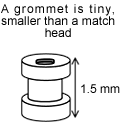
Tympanostomy tube
Encyclopedia

Eardrum
The eardrum, or tympanic membrane, is a thin membrane that separates the external ear from the middle ear in humans and other tetrapods. Its function is to transmit sound from the air to the ossicles inside the middle ear. The malleus bone bridges the gap between the eardrum and the other ossicles...
in order to keep the middle ear
Middle ear
The middle ear is the portion of the ear internal to the eardrum, and external to the oval window of the cochlea. The mammalian middle ear contains three ossicles, which couple vibration of the eardrum into waves in the fluid and membranes of the inner ear. The hollow space of the middle ear has...
aerated for a prolonged period of time, and to prevent the accumulation of mucus
Mucus
In vertebrates, mucus is a slippery secretion produced by, and covering, mucous membranes. Mucous fluid is typically produced from mucous cells found in mucous glands. Mucous cells secrete products that are rich in glycoproteins and water. Mucous fluid may also originate from mixed glands, which...
in the middle ear. The operation to insert the tube involves a myringotomy
Myringotomy
Myringotomy is a surgical procedure in which a tiny incision is created in the eardrum, so as to relieve pressure caused by the excessive build-up of fluid, or to drain pus. Myringotomy is often performed as a treatment for acute suppurative otitis media...
. The tube itself is made in a variety of designs. The most commonly used type is shaped like a grommet
Grommet
thumb|right|250px|Some rubber grommets.A grommet is a ring inserted into a hole through thin material, such as fabric. Grommets are generally flared or collared on each side to keep them in place, and are often made of metal, plastic, or rubber. They may be used to prevent tearing or abrasion of...
or T
T
T is the 20th letter in the basic modern Latin alphabet. It is the most commonly used consonant and the second most common letter in the English language.- History :Taw was the last letter of the Western Semitic and Hebrew alphabets...
. When it is necessary to keep the middle ear ventilated for a very long period, a "T"-shaped tube may be used. Materials used to construct the tube are most often plastics such as silicone
Silicone
Silicones are inert, synthetic compounds with a variety of forms and uses. Typically heat-resistant and rubber-like, they are used in sealants, adhesives, lubricants, medical applications , cookware, and insulation....
or Teflon. Stainless steel
Stainless steel
In metallurgy, stainless steel, also known as inox steel or inox from French "inoxydable", is defined as a steel alloy with a minimum of 10.5 or 11% chromium content by mass....
tubes exist, but are no longer in frequent use.
Although myringotomy with tube insertion can be performed under local anesthesia
Anesthesia
Anesthesia, or anaesthesia , traditionally meant the condition of having sensation blocked or temporarily taken away...
during a regular doctor's appointment in co-operative adults, patients requiring tube insertion are very often young children. Since damage to the ear is possible unless the patient stays quite still while being manipulated, for any patient who may have difficulty lying still during the procedure, myringotomy and tube insertion is performed under a brief general anesthesia.
The insertion of tympanostomy tubes is one of the most common surgical procedures performed on children. In the USA, it is the most common reason for a child to undergo a general anaesthetic. T-Tubes can last up to 5 years or more. When the tubes are released from the ear, it is usually covered in a mini- goiter of wax. Nausea and vomiting is very common when the tubes fall out. (Due to equilibrium that may need to pressurize the balance of the ear) It may last for up to 48 hours on some occasions.
Tympanostomy tubes generally remain in the eardrum for some period of time, ranging from 2 years to 5 years, before spontaneously falling out of the eardrum. The eardrum usually (but not always) closes without a residual hole at the tube site.
Long term studies have called the necessity of routine ear tube surgery into question.

